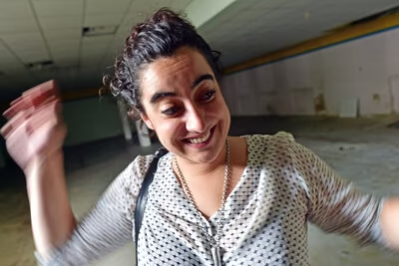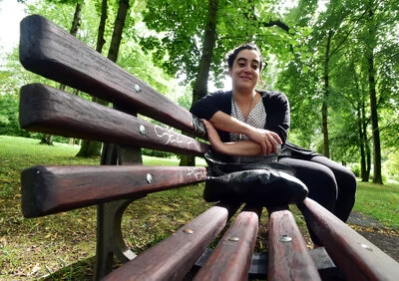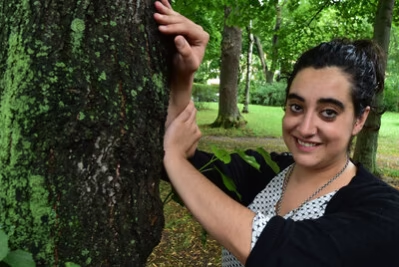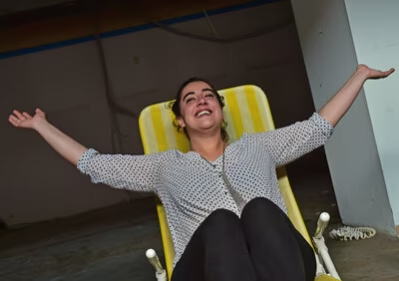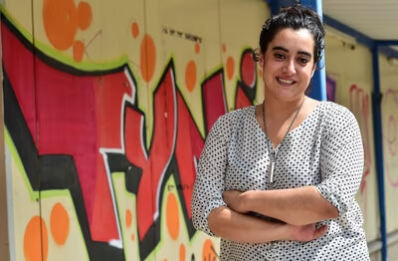Chemnitz and the importance of a second look
Marta Gonzalez de Mendibil
The Chemnitz art and culture festival Begehungen is taking place for the eleventh time. From 14 - 17 August, nine national and international artists will be performing on Rosenplatz in the Bernsdorf district. For Marta Gonzalez de Mendibil, it's not just a festival. Because she not only identifies with the third-largest city in eastern Germany, but also wants to "do something", she has been active in the BEGEHUNGEN e.V. association for three years. That's why she is this week's doer on behalf of the volunteers in the organisation.
Do you know how the idea of BEGEHUNGEN came about?
Marta Gonzalez de Mendibil: Eleven years ago, Beate Kuhnath and Lars Neuenfeld realised the idea on the Sonnenberg for the first time, also with the idea of using vacant buildings or premises. They organised a small photo exhibition, invited photographers and showed photos in empty shops. After another association took over the organisation of the tours, the festival moved to the Brühl. And a few years ago, the association BEGEHUNGEN e. V. was finally founded, which moved into ever-changing premises with the Begehungen. We have already been in the former prison on the Kaßberg and the former "Forum" event complex.
What motivated you to join the association?
I had already been in Chemnitz for four years, lived in a hall of residence on the campus and had no idea what was going on in the city. I just consumed culture. That was okay. I saw places and thought: they do cool things. It wasn't until I moved to Kaßberg that everything changed for me. I met new people, went to Weltecho and the club cinema a few times. Then a friend said to me: if you want to do something, you could come to the BEGEHUNGEN meeting.
I just thought, BEGEHUNGEN - what's that? Then I went to the meeting and thought it was cool. I felt comfortable here and no longer just wanted to consume culture, I wanted to do something.
Now you're no longer "just" involved, you're also the chairwoman of the organisation.
I've been a board member since last year. But that doesn't mean much. We are a very democratic organisation. So I don't make any decisions on my own. (laughs)
How does the organisation of the festival work?
(Laughs) Sometimes a bit chaotic. After the festival is before the festival. We meet every fortnight, brainstorm, think about themes and locations where the festival can take place next year. It's quite a long process. The location and the theme should make sense together. We do have vacant properties in Chemnitz, but it's not always easy to find a suitable location. That's why we go on excursions, walk around the city and look for vacant buildings. We then try to get an idea of the buildings, inspect them and clarify the appropriate theme. And finally, the buildings have to be of a certain standard: For example, we always need electricity and water to hold the festival.
What criteria are used to select the artists who take part in BEGEHUNGEN?
We have a lot of applications every year. There have been years when we have had more than 400 submissions from all over the world. Of course, we are delighted with every single application, but they also present us with a challenge. Because that means reading every concept, understanding it and considering whether it fits the theme. The selection is then made by a jury, which this year consisted of Katja Manz (urban geographer), Olaf Held (director and screenwriter), Anja Engel (board member of the LOCALIZE Festival Potsdam) and Begehungen e. V. The jury evaluates the concepts according to formal and aesthetic aspects, but also to what extent the respective concept fits the theme and the location. As we are a festival that emphasises the promotion of up-and-coming artists, this is of course also a selection criterion.
Are the artists paid for their work in Chemnitz?
Two or three years ago, we didn't pay the artists. They only received a small allowance. We wanted to change that because the artists ultimately have to make a living from their artistic work. The artists come here for four weeks and develop something - that's what they should be paid for. This is another reason why the number of participating artists is smaller compared to the event at Kaßberg Prison three years ago. Back then there were 50 and this year there are nine artists, but they are paid.
Can you talk about the artists' fees?
Our work for the art and culture festival is transparent. That's why I'm allowed to talk about it. Each of the participants receives 1,200 euros for their work during the four weeks here in the city.
The artists are accommodated in Chemnitz during the four weeks?
Yes, last year we did it for the first time, inviting nine artists and accommodating them here for the entire time. It worked so well that we thought: We'll do it again this year. The view that people from outside bring with them and develop here is very important. Not just for us. What do they think about the city, for example? They come up with answers that we, who have lived here for so long, have long forgotten or that are already totally normal for us.
There is a dialogue with people who actually have nothing to do with Chemnitz. Especially as many of them don't come from Germany, but from abroad. We have a really good feeling when we manage to get people to come here, feel comfortable and speak positively about the city. That is a success for us. Last year there was a Spaniard who now lives in Chemnitz (laughs). He was here, worked as an artist for BEGEHUNGEN, went back to Spain, wrote his final thesis and came back in December. I find that incredible.
Why are the BEGEHUNGEN so important for Chemnitz?
I think the BEGEHUNGEN are important because they try to bring a different perspective to the city. They try to see vacancies not just as a problem, but also as an opportunity or possibility for something new. It's a problem, but also an opportunity to open up and say: we have so many empty buildings - let's make something out of them. I think that's important for BEGEHUNGEN, and also that we manage to bring nine artists to Chemnitz who might become our new ambassadors afterwards. Who will go home and tell everyone how great it was here.
Would you describe Chemnitz as an art city?
There are actually many galleries here in the city, then there are the art collections, the Gunzenhauser Museum and many other museums. You could call it an art city. I think Chemnitz has a lot to offer in terms of culture. I don't know why, but I didn't realise it at the beginning. I was a bit out of the loop in the hall of residence, I had to live here for two years and get to know the right people to see what there actually is here. Sometimes there are little surprises that you find in a hidden corner: Oh there's something here - another club and another gallery. You don't see that at first glance. And I like that too. You just have to give the second one a chance. But that's not easy either. At the beginning of my stay in Germany, I lived in Leipzig and learnt German. When I came to Chemnitz in October and saw the city, everything was so grey, I just thought: what am I doing here?
Why did you come to Germany seven years ago?
I did my A-levels in Spain and then wanted to do something new and experience something new. I went to Leipzig, learnt German quite intensively and didn't want to go back to Spain. The original plan was that I would go back to Spain after the year and study there. But I couldn't imagine doing that and ended up in Chemnitz.
Moving from Leipzig to Chemnitz is quite unusual.
That was also a coincidence. My first time in Chemnitz was my move. I had never been to Chemnitz before. My boyfriend already had a job here at the university. That was at the end of September and I hadn't applied anywhere. He asked at Chemnitz University of Technology whether I could still enrol and I could. That's how I ended up in Chemnitz, studying English and American Studies and I'm now almost finished.
Do you plan to continue living here after you graduate?
That's the big question now. We organise the BEGEHUNGEN on a voluntary basis and don't earn any money from it. I would love to stay here. I've found my city here with my people. I really didn't think that at the beginning. I feel at home here and would love to stay. I would be happy if I could earn a living with the BEGEHUNGEN.
This year, the organisers of the BEGEHUNGEN art and culture festival have chosen an open-air location for the first time. Rosenplatz in the Bernsdorf district, right next to the old EDEKA department store on the corner of Lutherstraße and Bernsdorfer Straße. "The BEGEHUNGEN have never been to Bernsdorf before. One point in favour of Rosenplatz," says Marta Gonzalez de Mendibil.
Which exhibition spaces are there this year?
The old EDEKA department store will be used as our festival centre. We're installing a supermarket here and showing the artists' documentation of how their work has developed during their time in Chemnitz. We will also provide insights into our work. We'll make ourselves "naked", so to speak, and publish our protocols. This will allow people to understand how the encounters came about. It will all be in the old EDEKA shopping centre. No works of art will be brought in. The exhibition venues will be Rosenplatz, the old ruined building further back and part of the old bunker.
Why should the people of Chemnitz come and see the BEGEHUNGEN art and culture festival?
Because it's something different. This year is the first time it's outside and I think that gives us a lot of freedom. It's a festival that we organise with a lot of love, sometimes in a bad mood and with a lot of stress. We also have workshops, interactive art to take part in and concerts. It's going to be great. BEGEHUNGEN doesn't charge admission and is therefore open to everyone. We're also fresh and cheeky. The city needs a bit of cheekiness. Not too much, but a little.
Where are the artists coming from this year?
From six countries: Portugal, the Netherlands, Romania, Scotland, Spain and Germany.
Where do the visitors come from - just Chemnitz?
No, they also come from Zwickau, Dresden, Leipzig and Berlin.
Is there a comparable festival in Germany?
There is one in Potsdam called the LOCALIZE Festival. It's similar to BEGEHUNGEN in that it also uses empty buildings or corners in Potsdam. But the big difference is that it's super hard to find vacancies in Potsdam.
The association members and you do it all on a voluntary basis. Where do you get your enthusiasm from?
I can only speak for myself: I want to be a part of this city and do something besides going out at night.
Originally from San Sebastián in northern Spain, she moved to Chemnitz via Leipzig around seven years ago. The initial scepticism has turned into genuine love between the industrial city and the 25-year-old student. "I've now found a second home here," she says, describing her feelings for the city. When I talk about Chemnitz in San Sebastián, I talk about home."
In seven years - what is special about Chemnitz for you?
The importance of taking a second look. You need shock therapy when you come to Chemnitz for the first time as a foreigner. I come from a pretty posh city in Spain. Then you come to Chemnitz via Leipzig - a city that is also really chic and has a lot to offer - and you just think: "What?". I think it's important to discover that there is a second glance. And I don't have that much green in my Spanish city. And so much space. The streets are so big, I have room to breathe and move around here.
A phenomenon: Chemnitz residents apologise for their city or for their origins. Hence our standard question: Do you have to encourage the people of Chemnitz?
Really? Well, I always say where I come from - Chemnitz. People don't believe me and then I say: Originally from Spain. And when people start talking funny about Chemnitz, I say: Have you ever been to Chemnitz? Come and visit and then you can judge. That's why the people of Chemnitz should be encouraged. I don't know why people keep apologising or why they think Chemnitz is so worthless. They don't need to do that.


